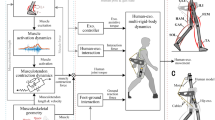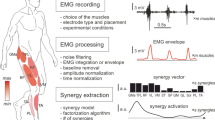Abstract.
In this study we have examined the ability of the central nervous system (CNS) to use spinal reflexes to minimize displacements during postural control while continuous force perturbations were applied at the hand. The subjects were instructed to minimize the displacements of the hand from a reference position that resulted from the force perturbations. The perturbations were imposed in one direction by means of a hydraulic manipulator of which the virtual mass and damping were varied. Resistance to the perturbations came from intrinsic and reflexive stiffness, and from the virtual environment. It is hypothesized that reflexive feedback during posture maintenance is optimally adjusted such that position deviations are minimal for a given virtual environment. Frequency response functions were estimated, capturing all mechanical properties of the arm at the end point (hand) level. Intrinsic and reflexive parameters were quantified by fitting a linear neuromuscular model to the frequency responses. The reflexive length feedback gain increased strongly with damping and little with the eigenfrequency of the total combined system (i.e. arm plus environment). The reflexive velocity feedback gain decreased slightly with relative damping at the largest eigenfrequency and more markedly at smaller eigenfrequencies. In the case of highest reflex gains, the total system remained stable and sufficiently damped while the responses of only the arm were severely underdamped and sometimes even unstable. To further analyse these results, a model optimization was performed. Intrinsic and reflexive parameters were optimized such that two criterion functions were minimized. The first concerns performance and penalized hand displacements from a reference point. The second one weights afferent control effort to avoid inefficient feedback. The simulations showed good similarities with the estimated values. Length feedback was adequately predicted by the model for all conditions. The predicted velocity feedback gains were larger in all cases, probably indicating a mutual gain limiting relation between length and velocity afferent signals. The results suggest that both reflex gains seem to be adjusted by the CNS, where in particular the length feedback gain was optimal so as to maximize performance at minimum control effort.
Similar content being viewed by others
Author information
Authors and Affiliations
Additional information
Received: 23 July 2001 / Accepted in revised form: 15 January 2002
Rights and permissions
About this article
Cite this article
de Vlugt, E., Schouten, A. & van der Helm, F. Adaptation of reflexive feedback during arm posture to different environments. Biol Cybern 87, 10–26 (2002). https://doi.org/10.1007/s00422-002-0311-8
Issue Date:
DOI: https://doi.org/10.1007/s00422-002-0311-8




